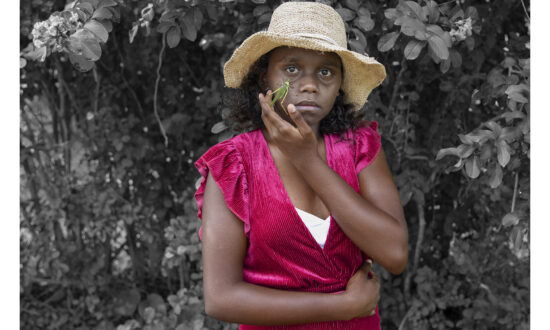The children in the small, hinged 19th-century photographs seem to float just above the seat of the chairs.
Margaret Ambridge found these unnerving historical images in a photographer’s collection. They stand on a plinth at the entrance to Embedded, her new exhibition at Gallery M.
In the 19th century, it took a long time to expose the photographic plates in the camera and the children had to stay still or they’d be blurred. They sat in the laps of their “hidden mothers” or women hired to keep them still, but the women were concealed under dark velvet drapery that hid their bodies and faces from the camera.
Ambridge first came across an image of a hidden mother on the web while researching the symbolic and political implications of veiling and unveiling female faces and bodies. Her response was immediate and gut-wrenching.
“I couldn’t let it go,” she says.
Concealing the mothers made them invisible and “disturbingly unimportant”. The energy and effort of motherhood was completely erased. “They were the children of the patriarchy.”
Now the artist has magnified the images of the children and the now-visible but cloaked women and captured them in her dramatic charcoal as the prologue to the exhibition.
Ambridge has long been fascinated by the flimsy tissue dress patterns produced to enable women to make their own version of the haute couture of the 1940s and ’50s. They featured in the ghostly wedding in her 2022 exhibition Becoming Invisible at praxis ARTSPACE, which won People’s Choice in the Dobell Drawing Prize 2023 and is touring nationally. But now, she’s using the tissue-thin paper to represent the embeddedness of women’s power, energy and creativity.
She explains the idea of “embedded” contribution, capacity and identity as manifested in the physical and emotional labour of making and maintaining a home, a family and relationships.
“A significant quantity of the work that women traditionally do – the cleaning, washing and presence of well-mannered children – is rendered invisible by the continuity of effort and subtle expectation,” she says.
Around the walls of the gallery the ages of women’s lives are portrayed in sculptures of torsos made of layers of the translucent tissue, wearing dresses of the same material that bear watercolours and linocuts marking their journey of self-understanding.
Ambridge has looked for the patterns everywhere, and they bear the notes and thoughts of previous makers.
Like the women she portrays, the tissue has strength, resilience and the ability to adapt to circumstance.
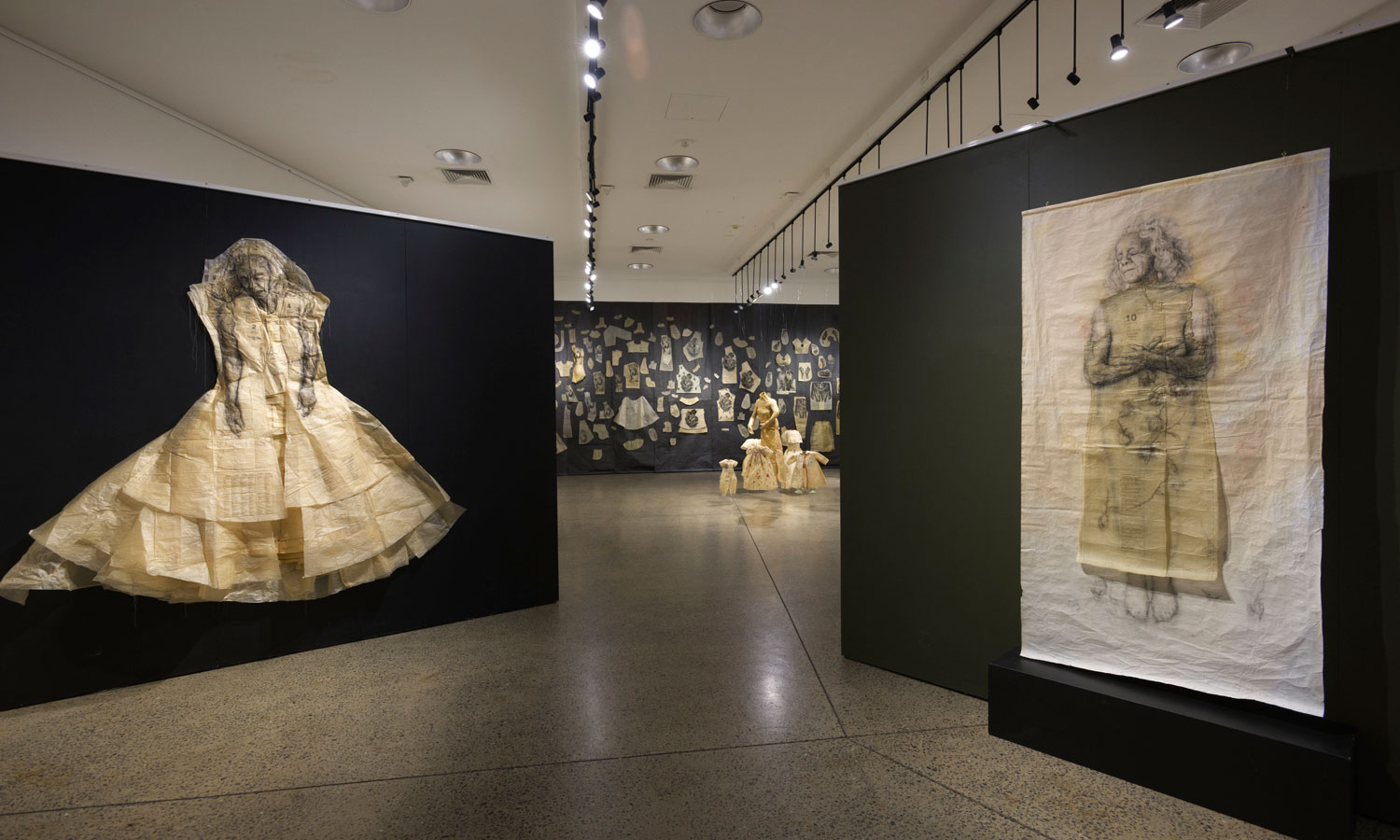
An installation view of Margaret Ambridge’s Embedded exhibition. Photo: Mark Fitz-Gerald
Before we enter the space we see an older woman clothed in an enormous ballgown, with her delightful unruly white hair and her neck and arms wrinkled. Opposite her is the same woman, the roses are now dying, but her face is transfixed with a new wisdom, beauty, acceptance of life and mortality.
Entering the main space, we see the torso of a young woman on the wall.
“She has curves in all the right places dressed in a 1940s/1950s dress. It’s covered in rosebuds portraying the youthfulness and the potential of the young,” Ambridge says.
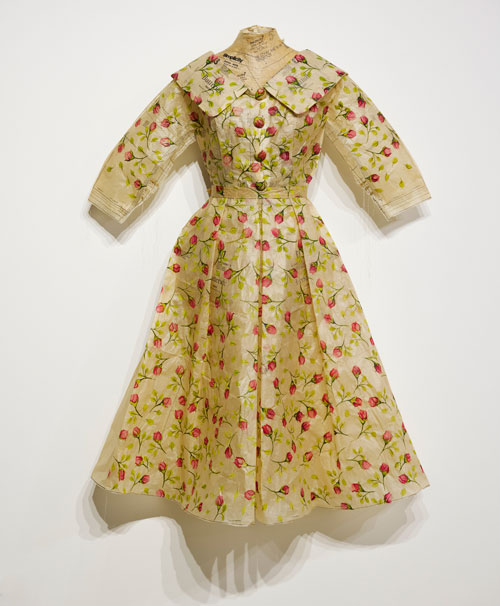
A work from Embedded, by Margaret Ambridge. Photo: Mark Fitz-Gerald
But the story of life becomes richer and more complex as she moves into motherhood. Suspended in the centre of the gallery we see the woman beyond middle age. She has a more rounded torso and is leaning forward into the complex, joyful and frustrating experience of child-raising, surrounded by sculptures of the children all made of the tissue paper patterns lovingly decorated. The roses on her dress are full-blown, and she’s giving life and dealing with its complexities.
Beyond her is another sculpture of the woman, aged now, but with a new kind of confident understanding of herself. Her dress bears images of aged hands.
To make this torso, Ambridge has moulded layers of the translucent paper on the body of her “muse”, sculptor and former teacher at Adelaide Central School of Art (ACSA) Renate Nisi.
“It’s her journey, too,” Ambridge says. “She loves the act of making the work and stimulating the conversation.”
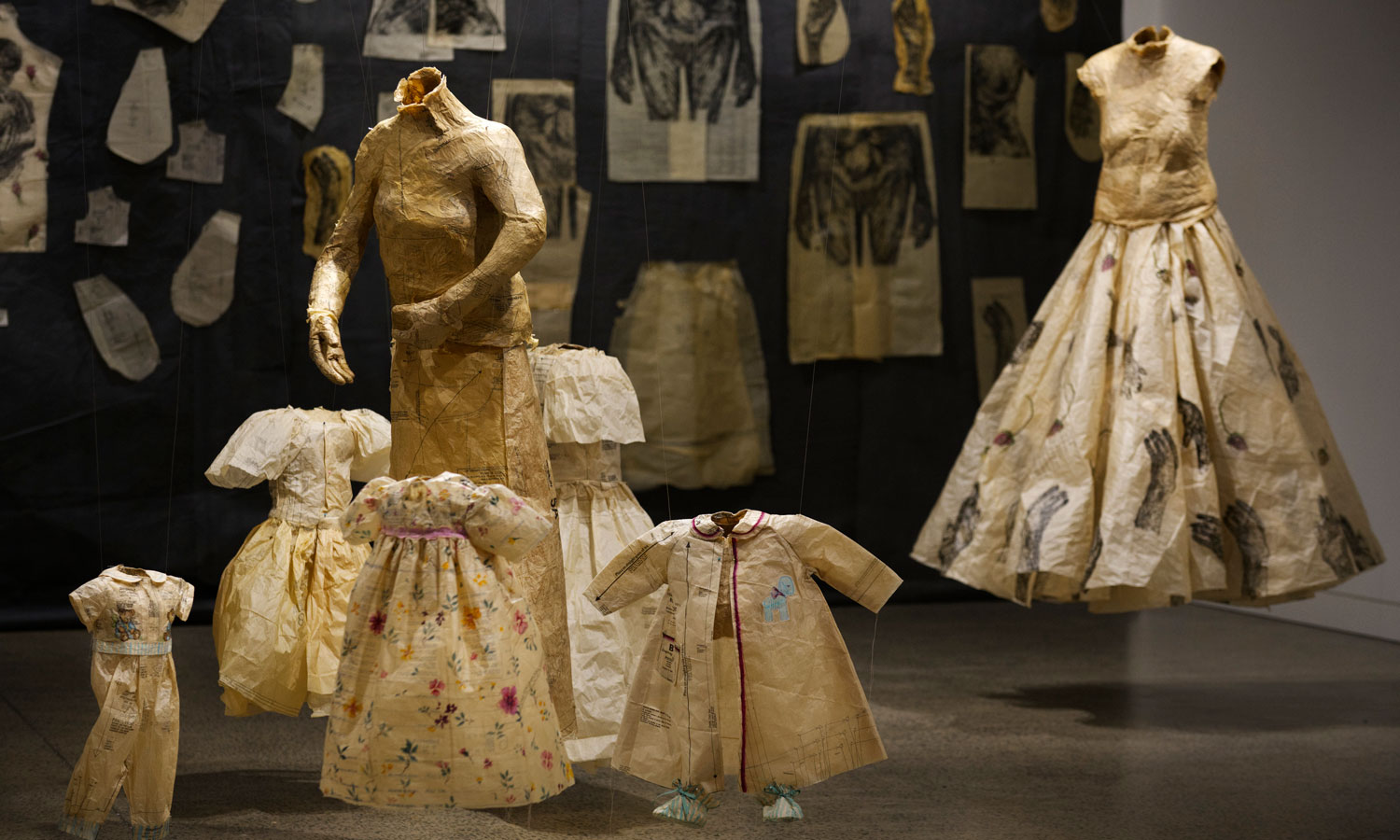
An installation view of Embedded, by Margaret Ambridge, at Gallery M. Photo: Mark Fitz-Gerald
Nisi was happy to be a nude model for Ambridge’s exploration of the process of women’s maturation and ageing.
“We all have bodies, and they all are aging. We all must confront the inevitability of this,” Nisi says.
“It has been a surprising pleasure to have Margaret draw my body, with all its faults and battle scars, and give it the generosity of many hours and caring attention in the process.”
Ambridge also admires the older woman’s frank unselfconsciousness about her body. “Ren’s incredibly generous and comfortable in her skin,” she says.
Later, we see her with the tissue dress opened to unveil a charcoal nude life-size portrait of Nisi’s mature ageing body.
“I love seeing all the curves and the forms and the flesh. I just think that’s so beautiful, and I can see that in the tissue,” Ambridge says.
“To me, that’s just beautiful, and it’s quite universal because you can see that in the trees, and you can see it in the vegetation and it’s just that’s what’s all around us.”
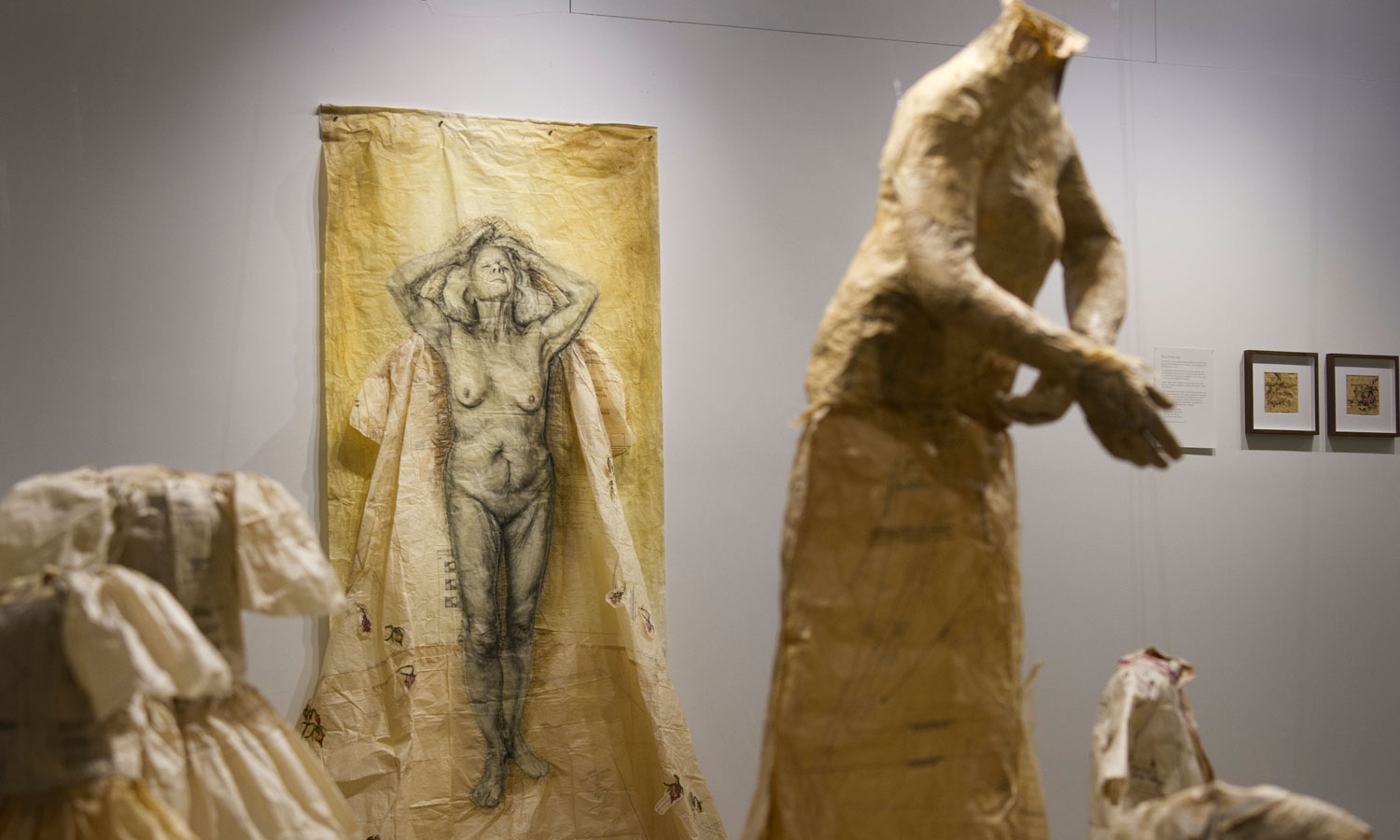
‘So beautiful’ – Embedded captures human vulnerability. Photo: Mark Fitz-Gerald
At the end of the exhibition, we see the older woman laid out in death. Her body lies on Ambridge’s grandparents’ old front door, her hands folded on her chest.
All too aware of my own ageing, I ask Ambridge how she feels about confronting hers.
“You know, we sign up for it when we’re born. We don’t have any choice. The alternative isn’t worth thinking about,” she says.
“It’s the doorway. It’s the end of life. Letting go. To me it’s just very symbolic of that. It will be the end of the day.
“It’s not a scary version of it. It’s peaceful. It’s restful. It’s on a door. It says something about ‘it’s home’.”
Artist Anna Platten, who launched the exhibition, says Ambridge is “incredibly courageous”.
“She’s tackling all these things that we are scared of confronting. She manages to capture women’s capacity, the human vulnerability, ageing and maturing: the things our culture is running away from.”
For Platten, the hi-tech consumer world’s message is that the solution to our existential problems is buying more stuff.
“The aim of the [consumer] game is to try to trick us into thinking that we have a magical control of the real issues of life: that maturing and ageing are not happening.”
Ambridge’s work shows us that the process “is happening and it’s alright”.
Pointing to Ambridge’s job as a physiotherapist with palliative patients, Platten says: “She’s someone who sees an awful lot of mortality in her work.
“We ultimately fear ageing, illness and death, and we’re frightened by the impossibility of the eternal. The idea that we can buy things as a way of distracting ourselves from the ultimate reality is a destructive fantasy that is having an impact on the environment, including our own humanity.”
She describes Ambridge’s work as “awesome, in the sense of awe inspiring, because it’s facing up to the big questions, and it’s all done so beautifully”.
“The making, itself, is part of the message: the interaction of hands and material has its own impact.”
Platten and Ambridge find comfort in the human: “It reminds us that mortality is irreversible. But that isn’t bad.”
Ambridge celebrates human growth and decline because it is the way of a natural world.
“She’s not decrying the beauty and the energy of youth, but her work is a celebration of all the stages of growth and development,” Platten says.

Get InReview in your inbox – free each Saturday. Local arts and culture – covered.
Thanks for signing up to the InReview newsletter.
Ambridge says she wants these works to stimulate conversations about women’s efforts and contributions over their lives; the physical and emotional heavy lifting that makes a home and sustains a relationship and a family.
Women bear the burden of judgment and the male gaze, but because we all, whatever our gender, go through the process of maturing and ageing and confronting our mortality, it’s impossible to look at these pieces without looking into oneself.
And the complexity of our responses to our own contribution and the ageing process means that there will be much deep discussion in the gallery and after.
Embedded, a solo exhibition of Margaret Ambridge’s work, is at Gallery M at the Marion Cultural Centre until May 5.
Support local arts journalism
Your support will help us continue the important work of InReview in publishing free professional journalism that celebrates, interrogates and amplifies arts and culture in South Australia.
Donate Here

